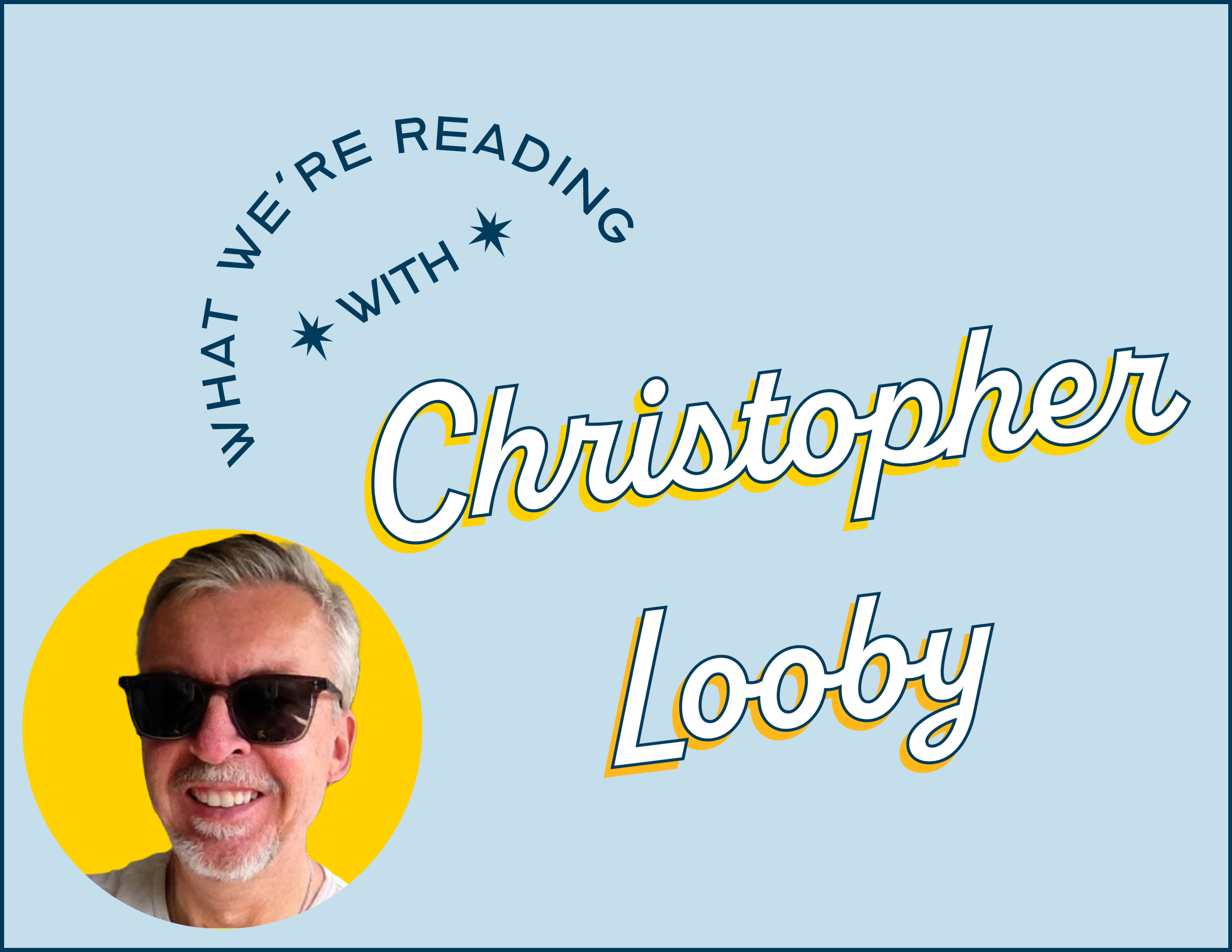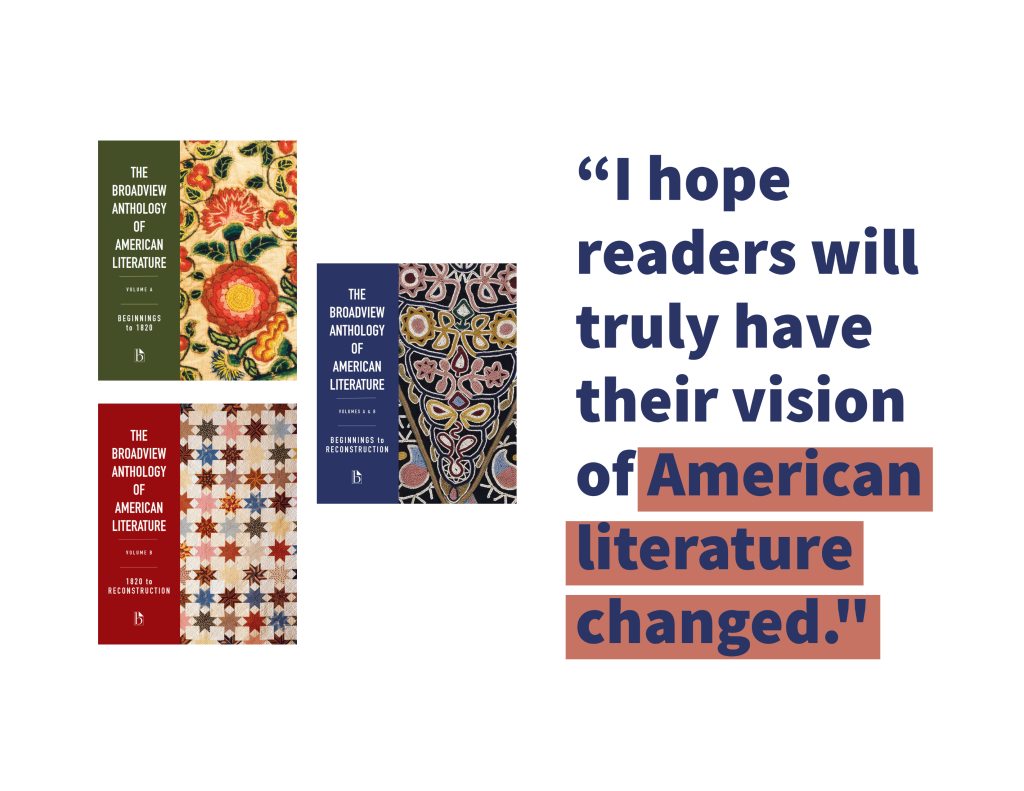What We’re Reading with Christopher Looby

Professor Christopher Looby served as one of the series General Editors for the new anthology series, The Broadview Anthology of American Literature, available through Broadview Press. We caught up with Professor Looby to talk about this new work.
Can you tell us a little bit about this anthology?
It’s a comprehensive anthology of American literature, meant chiefly for classroom use, comparable to the Norton Anthology of American Literature and the Heath Anthology of American Literature, but its aims are in some respects quite different from theirs. For example, like other anthologies it is organized chronologically for the most part, but we made a decision early on to violate chronology strategically on occasion, for instance at the start of Volume A. We chose to begin the volume with a section including “Indigenous Oral and Visual Literatures,” then follow that with a section entitled “Civilizations in Contact” (including texts from Vinland, the Caribbean, Mexico, Florida and New Mexico, the Northeastern woodlands, New France and California), follow that in turn with Cabeza de Vaca, and only after those feature white settler colonial figures such as John Smith, William Bradford, Roger Williams and Anne Bradstreet. In this way we sought to reorient readers’ attention quite materially, to disrupt received framings of what “American literature” is. Another example: Volume B starts with the Pequot writer and activist William Apess (1798-1839), and only after him includes selections from Catharine Maria Sedgwick (1789-1867) and James Fenimore Cooper (1789-1851), even though they are, strictly speaking, earlier figures.
How did you become interested or involved in this anthology series?
Don LePan, Broadview Press founder and CEO, approached me several years ago with an invitation to serve as one of the anthology’s general editors. At first I was somewhat reluctant, mainly because I don’t usually use an anthology in my classes—our short ten-week quarters at UCLA, as well as the fact that our upper-level surveys of American literature (166A, B, and C; 170A, B, and C) all cover relatively restricted time periods, make using a comprehensive anthology that covers a long span of years somewhat impractical. But Don was persuasive and the group of general editors he assembled (including our own 2009 Ph.D., Joseph Rezek, and our UC Irvine and UC Davis colleagues, Rodrigo Lazo and Hsuan L. Hsu, respectively) was so impressive that I agreed to participate.
What was the process like putting this anthology together? How did you and your fellow editors decide what to include?
It was a long and complicated process. Don and his staff at Broadview did extensive market research, questioning hundreds of college and university teachers about the likelihood that they would actually assign particular texts, since there would be no point in creating an anthology that didn’t have the contents that instructors really want to teach. They then drew up a proposed table of contents, which the general editors met to discuss and revise in light of our collective goals—among which was the intention to make the Broadview’s contents substantially more diverse (in multiple ways) than its competitors. We subtracted some items and added others, and helped decide which would go into the print book and which would go into the extensive website that accompanies the book. There were also sixteen “contributing editors,” twenty “contributing writers,” and over eighty “editorial advisors” (including our departmental colleague, Michael Cohen) who were consulted about specific matters. All in all, it was a massive collaboration beautifully orchestrated by Don and by Laura Buzzard, who together acted as “managing editors,” as well as many others on the staff at Broadview. I would be remiss if I didn’t emphasize very strongly that the heavy lifting was really done by the folks at Broadview. We as general editors set policy and determined general principles, such as the violation of chronology I mentioned earlier, as well as weighing in on specific contents. But the people at Broadview are deeply experienced (they had earlier produced the Broadview Anthology of British Literature) and impressively learned and scholarly, and along with the other general editors I have come away with great respect for their expertise and judgment.

What do you hope readers come away with after reading these anthologies?
I hope readers will truly have their vision of American literature changed. The volumes have large sections covering “Immigration and Indentured Servitude,” “Slavery and Resistance,” “Rebellions and Revolution,” “Popular Literature and Print Culture” (these are all in Volume A), “Nature and the Environment,” “Expansion, Native American Expulsion, and ‘Manifest Destiny,’” “Nineteenth-Century Oratory,” “Slavery and Abolition,” “African American Oral Literature,” “The Civil War and Its Literature,” “Popular Literature and Print Culture” (again), and “Gender and Sexuality” (Volume B). I would like to think that we are both expanding and shifting what counts as “literature” and also what counts as “American.” So far we have finished Volumes A (Beginnings to 1820) and B (1820 to Reconstruction); at least two, and maybe three, more volumes will follow, bringing us up to the present. We’re working on those now. As we speak I’m assembling possible contents for a section on “Gender and Sexuality” for Volume C. And there will also be “Concise” editions, whittling each of the volumes down for instructors who don’t want or need such extensive contents (Volume B, for example, has 1379 pages, plus all the website content!).
Do you have a favorite story that is included in either anthology?
It’s very hard to pick just one, but since I was instrumental in getting it included I would mention the anonymous story entitled “The Man Who Thought Himself a Woman” (1857), in Volume B, a very early representation of someone we would call a trans woman today. More generally, I’m happy to have played a role in including a rich selection of material having to do with gender, sexuality, and queerness of various kinds.
Do you have any other projects on the horizon that you’d like to share or talk a bit about?
I edit a series for the University of Pennsylvania Press called “Q19: The Queer American Nineteenth Century.” Three volumes are already in print (an anthology of short stories entitled “The Man Who Thought Himself a Woman” and Other Queer Nineteenth-Century Short Stories, a novel by Theodore Winthrop called Cecil Dreeme, and Margaret J. M. Sweat’s novel Ethel’s Love-Life), and a fourth is now in press—a formally experimental novel by Charles Warren Stoddard entitled For the Pleasure of His Company: An Affair of the Misty City, Thrice Told. Stoddard has sometimes been called “the American Oscar Wilde.” This, his only novel, is a marvelous, quasi-autobiographical tale of bohemian San Francisco in the nineteenth century featuring an aspiring writer named Paul Clitheroe and his friends, fellow writers, artists, actors, journalists, priests, and so forth. My edition also includes a selection of Stoddard’s South Sea sketches, since Paul, the protagonist, at the end of his tale jumps ship and voyages off with some indigenous friends from Hawai’i, just as Stoddard did. This will be published in March 2023, with my introduction and extensive annotations.